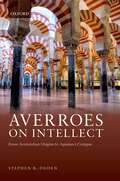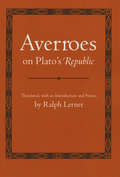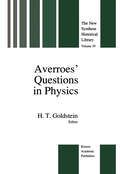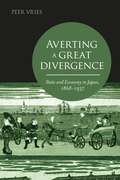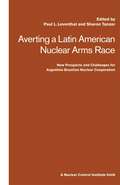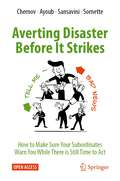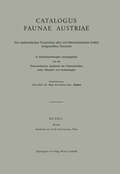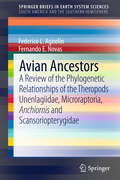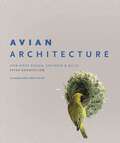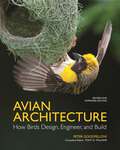- Table View
- List View
Averroes on Intellect: From Aristotelian Origins to Aquinas' Critique
by Stephen R. OgdenAverroes on Intellect provides a detailed analysis of the Muslim philosopher Averroes (Ibn Rushd)'s notorious unicity thesis — the view that there is only one separate and eternal intellect for all human beings. It focuses directly on Averroes' arguments, both from the text of Aristotle's De Anima and, more importantly, his own philosophical arguments in the Long Commentary on the De Anima. Stephen Ogden defends Averroes' interpretation of De Anima using a combination of Greek, Arabic, Latin, and contemporary sources. Yet, Ogden also insists that Averroes is not merely a 'commentator' but an incisive philosopher in his own right. The author thus reconstructs and analyzes Averroes' two most significant independent philosophical arguments, the Determinate Particular Argument and the Unity Argument. Alternative ancient and medieval views are also considered throughout, especially from two important foils before and after Averroes, namely, Avicenna (Ibn Sina) and Thomas Aquinas. Aquinas' most famous and penetrating arguments against the unicity thesis are also addressed. Finally, Ogden considers Averroes' own objections to broader metaphysical views of the soul like Avicenna's and Aquinas', which agree with him on several key points including the immateriality of the intellect and the individuation of human souls by matter, while still diverging on the number and substantial nature of the intellect. The central goal of this book is to provide readers with a single study of Averroes' most pivotal arguments on intellect, consolidating and building on recent scholarship and offering a comprehensive case for his unicity thesis in the wider context of Aristotelian epistemology and metaphysics.
Averroes on Plato's "Republic" (Agora Editions)
by Averroes"Because of the importance of Averroes (as a Muslim he is significant for both Platonic and Islamic thought), it is good to have Lerner's new and thoughtful interpretation, with lucid introduction, three helpful appendixes, glossary, and index."—Library Journal"This is a fine translation of a very difficult and important text, lost in its Arabic original but preserved in the awkward fourteenth-century Hebrew translation of Judah ben Samuel. Even in this summary form, the Republic is one of the exceedingly few works of the Platonic corpus to surface in Islamic philosophy, and this paraphrase is an excellent example of Averroes' technique of doing philosophy in commentary form."—Journal of Near Eastern Studies"It is interesting to note that Plato's tenets were considered profitable also by Averroes, whose world was defined and governed by the Koran."—The Classical OutlookAn indispensable primary source in medieval political philosophy is presented here in a fully annotated translation of Averroes' discussion of the Republic. Averroes' book played a major role in both the transmission and the adaptation of the Platonic tradition in the West. In a closely argued critical introduction, Ralph Lerner addresses several of the most important problems raised by the work.
Averroes’ Questions in Physics (The New Synthese Historical Library #39)
by Helen TunikGoldsteinoverall title and the commentary of Narboni, but in which the treatise is given a close association rath De Substantia Orbis VII, which immedi ately follows it in the text. This third version is the sole case in which a Hebrew translator can be named: the translation was made by Todros Todrosi in the year 1340. The only conclusion to be drawn from his translation is that Todrosi may definitively be eliminated as the translator of any of the other ver sions. However, we may be able to draw a tentative conclusion as to the formation of the Hebrew collection. The earliest evidence for the existence of the nine treatise collec tion is the commentary of Narboni, completed in 1349. The fact that nine years earlier one treatise could be attached to a work outside the corpus may indicate that the Hebrew collection of nine treatises was formed during those nine years, or mar even indicate that Narboni him self collected the various treatises. 5 Narboni, however, was not the translator of these works In fact, no 1 definitive indication of the translator's identity exists. 6 3. The Nature of the Question-Form Steinschneider offered the following general characterization of Aver roes' Quaestiones: These are mostly brief discussions, more or less answers to questions; they may be partially occasioned by topics i9 his commentaries and may be considered as appendices to them.
Aversion and Erasure: The Fate of the Victim after the Holocaust
by Carolyn J. DeanIn Aversion and Erasure, Carolyn J. Dean offers a bold account of how the Holocaust's status as humanity's most terrible example of evil has shaped contemporary discourses about victims in the West. Popular and scholarly attention to the Holocaust has led some observers to conclude that a "surfeit of Jewish memory" is obscuring the suffering of other peoples. Dean explores the pervasive idea that suffering and trauma in the United States and Western Europe have become central to identity, with victims competing for recognition by displaying their collective wounds. She argues that this notion has never been examined systematically even though it now possesses the force of self-evidence. It developed in nascent form after World War II, when the near-annihilation of European Jewry began to transform patriotic mourning into a slogan of "Never Again": as the Holocaust demonstrated, all people might become victims because of their ethnicity, race, gender, or sexuality—because of who they are.The recent concept that suffering is central to identity and that Jewish suffering under Nazism is iconic of modern evil has dominated public discourse since the 1980s. Dean argues that we believe that the rational contestation of grievances in democratic societies is being replaced by the proclamation of injury and the desire to be a victim. Such dramatic and yet culturally powerful assertions, however, cast suspicion on victims and define their credibility in new ways that require analysis. Dean's latest book summons anyone concerned with human rights to recognize the impact of cultural ideals of "deserving" and "undeserving" victims on those who have suffered.
Aversion, Avoidance, and Anxiety: Perspectives on Aversively Motivated Behavior
by Trevor Archer Lars-Goran NilssonBased on a conference held at the University of Umea, Sweden, these papers discuss the scientific status of the field of aversive learning from historical, affective, clinical, neurobiological, cognitive, neuroethological, and conceptual perspectives. Aversion, Avoidance, Anxiety carries readers through the history of the field's development, looks at the current state of progress, and discusses future research and therapeutic possibilities. The editors provide introductions to each chapter containing both timely information and background data to help readers systhesize and assimilate the information.
Aversion, Avoidance, and Anxiety: Perspectives on Aversively Motivated Behavior
by Trevor Archer Lars-Gören NilssonBased on a conference held at the University of Umea, Sweden, these papers discuss the scientific status of the field of aversive learning from historical, affective, clinical, neurobiological, cognitive, neuroethological, and conceptual perspectives. Aversion, Avoidance, Anxiety carries readers through the history of the field's development, looks at the current state of progress, and discusses future research and therapeutic possibilities. The editors provide introductions to each chapter containing both timely information and background data to help readers systhesize and assimilate the information.
Aversive Conditioning and Learning
by F. Robert BrushAversive Conditioning and Learning covers the significant advances in establishing the phenomena, principles, and other aspects of aversive conditioning and learning. This book is organized into three sections encompassing nine chapters. The first section deals with operant and classical conditioning of responses of the autonomic nervous system and with behavioral measurement of conditioned fear. The next section discusses the mechanism of avoidance learning and a number of problem areas, including the effects of response selection on the ease of acquisition and the nature and slow time course of the processes that reinforce avoidance learning. Other problems explore are the influence on avoidance learning of prior experience with uncontrollable shock and with reliable and unreliable predictors of shock, an analysis of avoidance learning in terms of a Markov model of short- and long-term memory, and the nature of retention of conditioned fear and the possible hormonal mechanisms that control performance motivated by fear. The last section examines some of the unexpected effects of punishment, which usually produces suppression of behavior. This section emphasizes the effects of noncontingent aversive stimuli that may account for the suppressive effects of punishment and on the paradoxical facilitation of behavior that sometimes results from response-contingent shock. This book will prove useful to medical psychologists, psychiatrists, and workers in the related fields.
Aversive Interpersonal Behaviors: Aversive Behaviors In Interpersonal Relationships (The Springer Series in Social Clinical Psychology)
by Robin M. KowalskiAversive behaviors have greater influence on social interactions than is generally acknowledged, determining personal satisfaction, interpersonal attraction, choice of partners, and the course of relationships. What motivates aversive behaviors? To what extent do they obtain desired outcomes? In what ways are they unnecessary and destructive? How do other people respond, emotionally and behaviorally? These are just a few of the many interesting questions addressed by the 16 respected researchers who contribute to Aversive Interpersonal Behaviors. Nine chapters give this heretofore neglected subject the attention it is due, probing a dark side of interpersonal relationships to understand both its destructive and adaptive nature.
Averting a Great Divergence: State and Economy in Japan, 1868-1937
by Peer VriesThe most significant debate in global economic history over the past twenty years has dealt with the Great Divergence, the economic gap between different parts of the world. Thus far, this debate has focused on China, India and north-western Europe, particularly Great Britain. This book shifts the focus to ask how Japan became the only non-western county that managed, at least partially, to modernize its economy and start to industrialize in the 19th century. Using a range of empirical data, Peer Vries analyses the role of the state in Japan's economic growth from the Meiji Restoration to World War II, and asks whether Japan's economic success can be attributed to the rise of state power. Asserting that the state's involvement was fundamental in Japan's economic 'catching up', he demonstrates how this was built on legacies from the previous Tokugawa period. In this book, Vries deepens our understanding of the Great Divergence in global history by re-examining how Japan developed and modernized against the odds.
Averting a Great Divergence: State and Economy in Japan, 1868-1937
by Peer VriesThe most significant debate in global economic history over the past twenty years has dealt with the Great Divergence, the economic gap between different parts of the world. Thus far, this debate has focused on China, India and north-western Europe, particularly Great Britain. This book shifts the focus to ask how Japan became the only non-western county that managed, at least partially, to modernize its economy and start to industrialize in the 19th century. Using a range of empirical data, Peer Vries analyses the role of the state in Japan's economic growth from the Meiji Restoration to World War II, and asks whether Japan's economic success can be attributed to the rise of state power. Asserting that the state's involvement was fundamental in Japan's economic 'catching up', he demonstrates how this was built on legacies from the previous Tokugawa period. In this book, Vries deepens our understanding of the Great Divergence in global history by re-examining how Japan developed and modernized against the odds.
Averting a Latin American Nuclear Arms Race: New Prospects and Challenges for Argentine-Brazil Nuclear Co-operation
by Paul LeventhalViewed by experts as being on the threshold of acquiring nuclear weapons, Argentina and Brazil have recently taken steps to assure each other their nuclear programs are entirely peaceful. This reports on a 1989 conference that anticipated these events and explored the approaches being taken today.
Averting Disaster Before It Strikes: How to Make Sure Your Subordinates Warn You While There is Still Time to Act
by Dmitry Chernov Ali Ayoub Giovanni Sansavini Didier SornetteSome of the major industrial disasters could have been prevented. When the facts of what happened are established, their stories share a common thread: before things spiralled out of control, there were workers at the affected sites who knew that the situation was dangerous, and could become catastrophic unless immediate action was taken. But tragically, nobody dared to tell the decision-makers who could have authorized that action. With no idea of the risks they were taking, the people in charge continued as normal… and disaster struck. Because vital information about risks could not flow freely from the shop floor to the director’s office, the crucial decisions were not made in time. This observation has been documented in the following major technological accidents: Challenger space shuttle explosion (USA, 1986); Chernobyl nuclear plant disaster (USSR, 1986); Deepwater Horizon oil spill (USA, 2010); Fukushima-1 nuclear power plant disaster (Japan, 2011); and numerous other industrial disasters. After accidents like these, losses and costs for dealing with the consequences are often hundreds — or even thousands — of times greater than the finances that would have been required to deal with the risks when they were first recognized.This handbook is about how to transform the way large critical infrastructure companies communicate about safety and technological risks. It aims to support senior managers to get the information they need from their subordinates concerning the risks they are facing, in order to prevent accidents before it is too late.The recommendations in this handbook are based on interviews with 100 executives at various levels, working in 65 critical infrastructure companies around the world, in power, oil and gas, metals, chemicals and petrochemicals, mining and other industries.The recommendations of these leaders were also tested in the pilot project, in an industrial company which is the world leader in its sector. More than 400 managers at various levels of the corporate hierarchy, and employees at several of the company’s industrial plants, took part in the project.This open access handbook is written for the owners, senior managers, and industrial safety directors of critical infrastructure companies.
Averting Global War: Regional Challenges, Overextension, and Options for American Strategy
by H. GardnerAverting Global War examines major regional disputes and conflicts throughout the world as they impact upon both American domestic and foreign policy. These include: The ongoing _war on terrorism_; NATO enlargement to Russian borders; US intervention in Iraq; US confrontation with Iran; the feud between Israel and the Palestinians; the widening _zone of conflict_ from Central Asia to sub-Saharan Africa; the global ramifications of North Korea_s nuclear program and China_s claims to Taiwan; Venezuela_s _Bolivarian Revolution_ and the _war on drugs_ in Latin America, the domestic socio-political effects of Latin American immigration upon the US. The book_s goal is to articulate an irenic American strategy intended to resolve, or at least transform, a number of these disputes and conflicts so as to prevent them from further _deepening_ or _widening__and to avert the real possibility of major power confrontation involving both clandestine and overt methods of warfare.
Averting Nuclear War (Advanced Sciences and Technologies for Security Applications)
by Kyungkook Kang Jacek KuglerThis timely book offers a comprehensive examination of the current state of nuclear stability postures worldwide, effectively highlighting their inherent limitations. Through their analysis, the authors illustrate how the seemingly contradictory perspectives of deterrence optimists, disarmament idealists, and warfighting pessimists can be reconfigured into a unified approach towards achieving regional and global peace. They suggest that these strategies can be reconciled as complementary, rather than substitute approaches, to achieve the common goal of nuclear stability.To achieve this objective, the book employs a game-theoretical framework to analytically define the conditions for nuclear war. Drawing from extensive observations of significant crises, the model incorporates identifiable systemic regularities that influence the strategic decision-making process during severe crises and establish the prerequisites for different levels of nuclear confrontation. Additionally, by tracing the strategic-technological trajectories of nuclear powers, the authors present a novel analysis that explores the potential for stable coexistence to replace unstable confrontation between global powers, ultimately fostering nuclear peace.The author's theoretical explorations lead to the policy conclusion that establishing a nuclear oligopolistic hierarchy, under the leadership of preponderant global powers committed to a no-first-use pledge, presents the most effective international system for enhancing both regional and global nuclear stability. This book aims to surpass the Cold War origins of current nuclear strategy and develop a comprehensive policy framework that guarantees enduring nuclear stability in the contemporary world.
Avery's Diseases of the Newborn E-Book
by Christine A. Gleason Sherin DevaskarAvery’s Diseases of the Newborn, edited by Christine A. Gleason and Sherin U. Devaskar, is a practical, clinical reference for diagnosing and managing of all the important diseases affecting newborns. Thoroughly revised by a team of new editors, this edition provides new perspectives and updated coverage of genetics, nutrition, respiratory conditions, MRSA, neonatal pain, cardiovascular fetal interventions, care of the late preterm infant, and more. This authoritative reference is ideal as a clinical resource or subspecialty review tool. Treat newborns effectively with focused coverage of diagnosis and management, including pertinent developmental physiology and the pathogenesis of neonatal problems. Meet every challenge you face in neonatology with Avery’s authoritative, comprehensive clinical resource and subspecialty review tool. Navigate quickly and easily with extensive cross-referencing throughout the organ-related sections. Stay current with coverage of hot topics including MRSA, neonatal pain, cardiovascular fetal interventions, care of the late preterm infant, and the developing intestinal microbiome. Tap into the fresh perspectives of new editors who provide extensive updates throughout, particularly on genetic and respiratory disorders. Apply the latest nutritional findings with thorough discussions of this valuable information in the more comprehensive nutrition section. Master the fundamentals of neonatology through the greater emphasis on developmental biology and pathobiology.
Avery's Diseases of the Newborn E-Book: Expert Consult - Online And Print
by Christine A. Gleason Sandra E JuulCovering the evaluation and management of every key disease and condition affecting newborns, Avery's Diseases of the Newborn, by Drs. Christine A. Gleason and Sandra E. Juul, remains your #1 source for practical, clinically relevant information in this fast-changing field. You'll find the specific strategies you need to confidently diagnose and treat this unique patient population, in a full-color, easy-to-use single volume that focuses on key areas of practice. Now in a thoroughly revised 10th Edition, this highly respected reference is an authoritative clinical resource for neonatal practitioners. - Provides up-to-date information on every aspect of newborn evaluation and management in a new, visually improved format featuring more than 500 all-new, full-color illustrations integrated within each chapter - Includes greatly expanded Neurology and Hematology sections that highlight the knowledge and expertise of new co-editor, Dr. Sandra E. Juul - Features all-new chapters on Palliative Care, Gastroesophageal Reflux, Platelet Disorders, Transfusion Therapy, Hypertension, , and The Ear and Hearing Disorders, as well as expanded coverage of brain injury and neuroprotective strategies in the preterm and term infant - Contains new Key Points boxes at the beginning of every chapter - Brings you up to date on current topics such as the evolving epidemic of neonatal abstinence syndrome and the new clinical uses of ultrasound (including ultrasound videos online) - Expert Consult™ eBook version included with purchase. This enhanced eBook experience allows you to search all of the text, figures, and references from the book on a variety of devices - Provides up-to-date information on every aspect of newborn evaluation and management in a new, visually improved format featuring more than 500 all-new, full-color illustrations integrated within each chapter. - Includes greatly expanded Neurology and Hematology sections that highlight the knowledge and expertise of new co-editor, Dr. Sandra E. Juul. - Features all-new chapters on Palliative Care, Gastroesophageal Reflux, Platelet Disorders, Transfusion Therapy, Hypertension, , and The Ear and Hearing Disorders, as well as expanded coverage of brain injury and neuroprotective strategies in the preterm and term infant. - Contains new Key Points boxes at the beginning of every chapter. - Brings you up to date on current topics such as the evolving epidemic of neonatal abstinence syndrome and the new clinical uses of ultrasound (including ultrasound videos online). - Expert Consult™ eBook version included with purchase. This enhanced eBook experience allows you to search all of the text, figures, and references from the book on a variety of devices.
Avery's Neonatology Board Review E-Book: Certification and Clinical Refresher
by Patricia R. Batchelor ChessAce your neonatology board exams and prepare for clinical practice with Avery's Neonatology Board Review: Certification and Clinical Refresher, 2nd Edition. This up-to-date review tool follows the exam blueprint, is based on the trusted content found in Avery's Diseases of the Newborn, and has been carefully tailored for effective exam review by renowned neonatologist and educator, Patricia Batchelor Chess, MD. Concise, relevant information is presented in a way that's easy to study and remember, giving you an important advantage on this challenging exam, as well as in the daily, fast-changing practice of neonatology.The most up-to-date, thorough, and effective board review book for neonatology . . . - Equips residents, fellows, and attending physicians with an efficient, comprehensive system for study, designed specifically to optimize performance on the board exam. - Presents information in a high-yield, outline format highlighted by key points, graphs, tables, images, and algorithms. - Includes expanded content on pulmonary mechanisms and on diversity and equity, reflecting the newly revised board exam core content outline. - Contains more than 450 board-style questions and answers, both in print and interactively online, related to each chapter. - Features board-style vignettes with full, discursive answers online. - Written by experts in the field of Neonatal-Perinatal Medicine and supporting subspecialists, representing a wealth of trusted insight and guidance.
Avery's Neonatology Board Review E-Book: Certification and Clinical Refresher
by Patricia R. Batchelor ChessPrepare for success on the neonatology boards and in clinical practice with Avery's Neonatology Board Review: Certification and Clinical Refresher. This highly practical review tool follows the exam blueprint, is based on the trusted content found in Avery's Diseases of the Newborn, and has been carefully tailored for effective exam review by renowned neonatologist and educator, Patricia Chess, MD. Concise, relevant information is presented in a way that's easy to study and remember, giving you an important advantage on this challenging exam, as well as in the daily, fast-changing practice of neonatology. - Equips residents, fellows, and physicians with an efficient, comprehensive system for study, designed specifically to help you perform at your best on the board exam. - Presents information in a high-yield, outline format highlighted by key points, graphs, tables, images, and algorithms. - Over 300 questions online - Features board-style vignettes in every chapter with full, discursive answers online. - Written by experts in the field of Neonatal-Perinatal Medicine, representing a wealth of trusted insight and guidance.
Avian Ancestors: A Review of the Phylogenetic Relationships of the Theropods Unenlagiidae, Microraptoria, Anchiornis and Scansoriopterygidae (SpringerBriefs in Earth System Sciences)
by Federico Agnolin Fernando E. NovasAlthough consensus exists among researchers that birds evolved from coelurosaurian theropods, paleontologists still debate the identification of the group of coelurosaurians that most closely approaches the common ancestor of birds. The last 20 years witnessed the discovery of a wide array of avian-like theropods that has considerably amplified the anatomical disparity among deinonychosaurians, some of which resemble Archaeopteryx more than Deinonychus. Among these newly discovered theropods that show remarkable bird-like characteristics are the four-winged theropods Microraptor and Anchiornis, and the unenlagiids Unenlagia, Buitreraptor, and Rahonavis. A bizarre group of minute-sized coelurosaurs, the Scansoriopterygidae, also exhibits some avian similarities that lead some authors to interpret them as more closely related to birds than other dinosaurs. With the aim to explore the phylogenetic relationships of these coelurosaurians and birds, we merged recently published integrative databases, resulting in significant changes in the topological distribution of taxa within Paraves. We present evidence that Dromaeosauridae, Microraptoria, Unenlagiidae, and Anchiornis + Xiaotingia form successive sister taxa of Aves, and that the Scansoriopterygidae are basal coelurosaurians not closely related to birds. The implications in the evolutionary sequence of anatomical characters leading to birds, including the origin of flight, are also considered in light of this new phylogenetic hypothesis.
Avian and Reptilian Developmental Biology: Methods and Protocols (Methods in Molecular Biology #1650)
by Guojun ShengThis volume discusses recent advances in avian and reptilian biology that have caused this diverse field to re-emerge. The chapters in this book are divided into 4 parts: genomics and transcriptomics, genetic manipulation, stem cells, and new model systems. Part I details how to perform genomic and transcriptomic analyses in birds and reptiles; Part II highlights technological advancements in avian genetic manipulation; Part III focuses on methods to handle pluripotent cells; and part IV looks at the emerging models in avian and reptilian developmental biology. Written in the highly successful Methods in Molecular Biology series format, chapters include introductions to their respective topics, lists of the necessary materials and reagents, step-by-step, readily reproducible laboratory protocols, and tips on troubleshooting and avoiding known pitfalls.Cutting-edge and comprehensive, Avian and Reptilian Developmental Biology: Methods and Protocols explores a variety of approaches and different sauropsid models that will help facilitate communication and collaboration among researchers, which in turn will progress this field forward.
Avian Architecture: How Birds Design, Engineer, and Build
by Peter GoodfellowBirds are the most consistently inventive builders, and their nests set the bar for functional design in nature. Avian Architecture describes how birds design, engineer, and build their nests, deconstructing all types of nests found around the world using architectural blueprints and detailed descriptions of the construction processes and engineering techniques birds use. This spectacularly illustrated book features 300 full-color images and more than 35 case studies that profile key species worldwide. Each chapter covers a different type of nest, from tunnel nests and mound nests to floating nests, hanging nests, woven nests, and even multiple-nest avian cities. Other kinds of avian construction--such as bowers and harvest wells--are also featured. Avian Architecture includes intricate step-by-step sequences, visual spreads on nest-building materials and methods, and insightful commentary by a leading expert. Illustrates how birds around the world design, engineer, and build their nests Features architectural blueprints, step-by-step sequences, visual spreads on nest-building materials and methods, and expert commentary Includes 300 full-color images Covers more than 100 bird species worldwide
Avian Architecture: How Birds Design, Engineer, and Build
by Peter GoodfellowBirds are the most consistently inventive builders, and their nests set the bar for functional design in nature. Avian Architecture describes how birds design, engineer, and build their nests, deconstructing all types of nests found around the world using architectural blueprints and detailed descriptions of the construction processes and engineering techniques birds use. This spectacularly illustrated book features 300 full-color images and more than 35 case studies that profile key species worldwide. Each chapter covers a different type of nest, from tunnel nests and mound nests to floating nests, hanging nests, woven nests, and even multiple-nest avian cities. Other kinds of avian construction--such as bowers and harvest wells--are also featured. Avian Architecture includes intricate step-by-step sequences, visual spreads on nest-building materials and methods, and insightful commentary by a leading expert. Illustrates how birds around the world design, engineer, and build their nests Features architectural blueprints, step-by-step sequences, visual spreads on nest-building materials and methods, and expert commentary Includes 300 full-color images Covers more than 100 bird species worldwide
Avian Architecture Revised and Expanded Edition: How Birds Design, Engineer, and Build
by Peter GoodfellowThe essential illustrated guide to how birds design and build their nests—now fully revised and expandedBirds are the most consistently inventive builders, and their nests set the bar for functional design in nature. Describing how birds design, engineer, and build their nests, Avian Architecture deconstructs all types of nests found around the world using architectural blueprints and detailed descriptions of the construction processes and engineering techniques birds use.This spectacularly illustrated book features more than 300 full-color images and more than 40 case studies that profile key species worldwide. Each chapter covers a different type of nest, from tunnel nests and mound nests to floating nests, hanging nests, woven nests, and even multiple-nest avian cities. Other kinds of avian construction—such as bowers and food stores—are also featured.Now with more case studies and an updated foreword, this revised and expanded edition includes intricate step-by-step sequences, visual spreads on nest-building materials and methods, and insightful commentary by a leading expert.Illustrates how birds around the world design, engineer, and build their nestsFeatures architectural blueprints, step-by-step sequences, visual spreads on nest-building materials and methods, and expert commentaryIncludes more than 300 full-color imagesCovers more than 100 bird species worldwide
